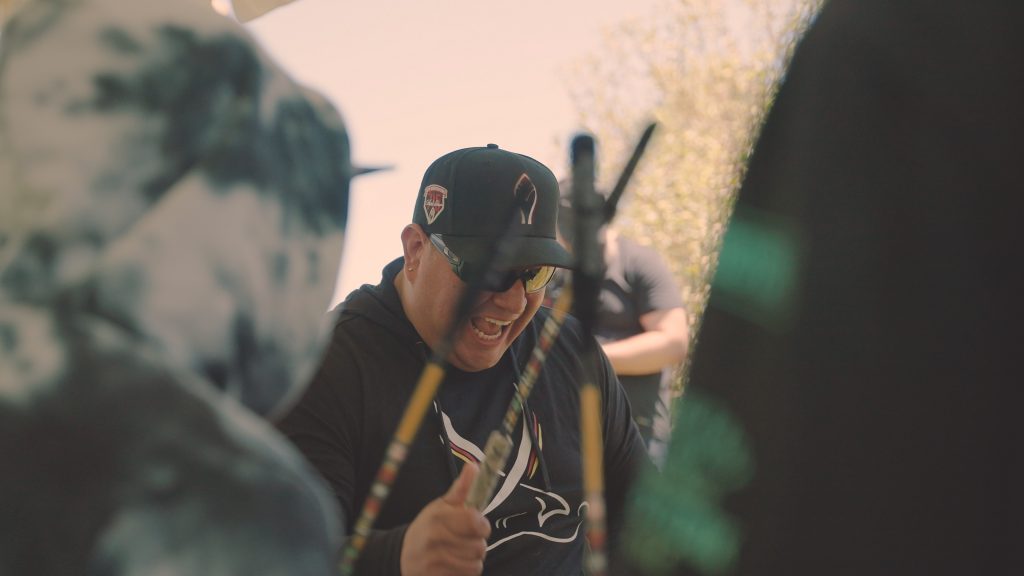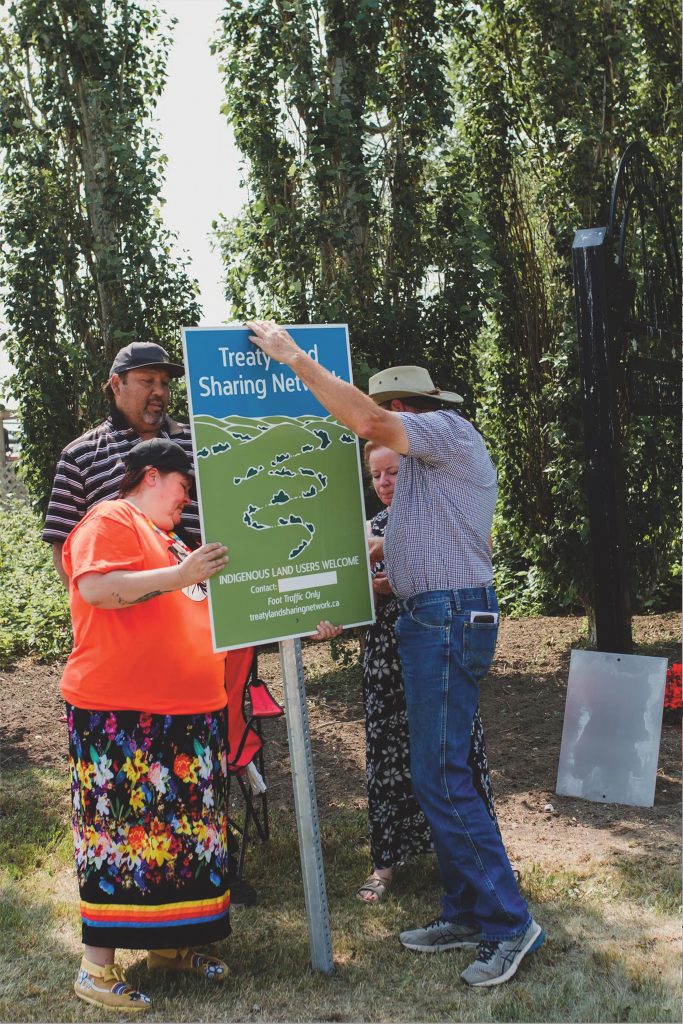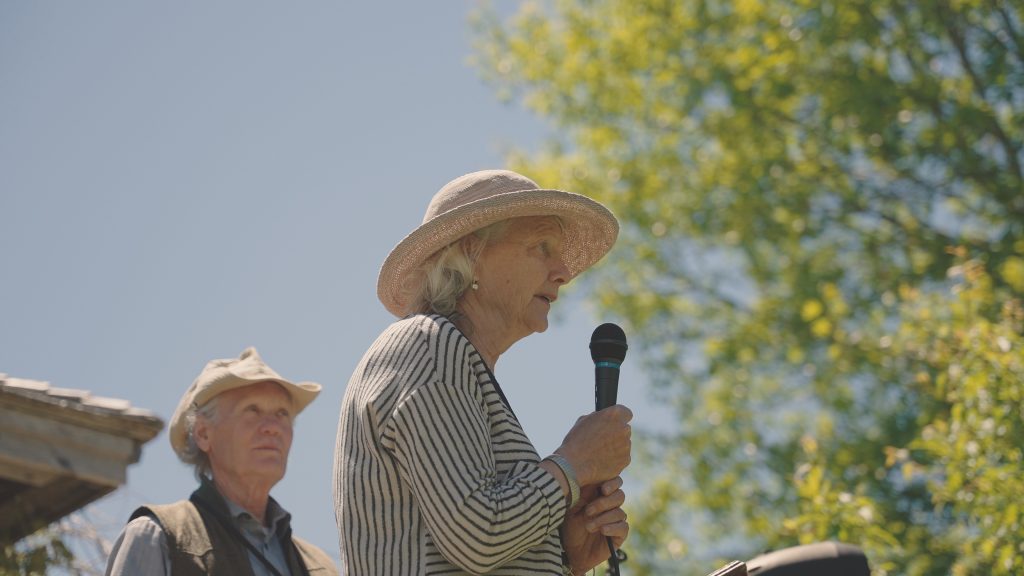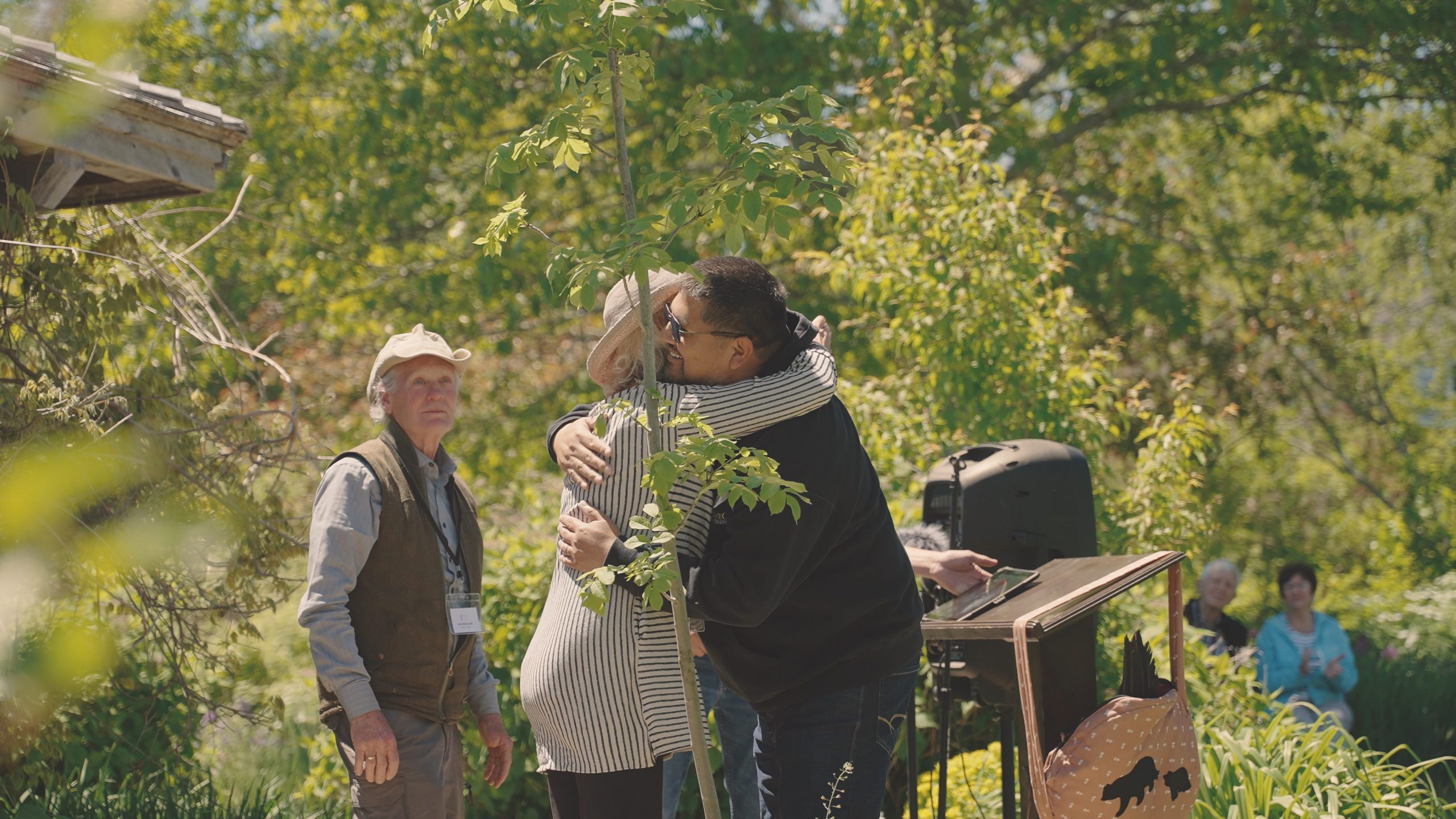Last June, Margaret Drescher prepared herself to finally pass along Windhorse Farm, a beloved retreat deep in the forest about an hour-and-a-half drive west of Halifax. All the official documents had been signed months before — the cerebral part of the transaction, she notes — but the June event wasn’t about paperwork or ownership. It was a spiritual return of the property.
Rejecting the idea of ownership, Drescher and her husband, Jim, had decided to turn over the roughly 80 hectares of old-growth forest to the Ulnooweg Education Centre, an Indigenous-led charitable organization that works with communities across Atlantic Canada. The Dreschers transferred the property for an amount (below market value) that would allow them to meet their needs, believing that the land belonged back in Indigenous hands. (They still live in their home on the neighbouring peninsula.)
That June day was full of Elders and children, with smudging and jingle dances and drumming. “There was just heart, there was humour,” says Drescher. “It was completely beautiful. Jim and I woke up the next morning, looked at each other and went, ‘Okay, things are different.’”
I first heard about the transfer of Windhorse Farm a year or so ago, and it followed another story that I read with curiosity: in July 2021, an Indigenous woman in British Columbia turned to social media to recruit settler Canadians to offer up their holiday homes for free vacations for “exhausted Indigenous kin.” Jacqueline Jennings tweeted, “Because of forced displacement, broken treaties, legislated poverty and land theft and the Indian Act, many Indigenous folks don’t have access to the intergenerational financial wealth (have other kinds) and credit to have a recreational property, 2nd or 3rd home.”

Pitching it as “soul cleansing restitution,” Jennings noted that “you won’t even have to give Land Back forever…just a couple of weeks by your pool/beach/lake/mountain.” Although I couldn’t find evidence that any homes changed hands, and Jennings didn’t respond to interview requests, her point was clear: Canadians need to make reconciliation more personal.
Most of Canada’s reconciliation process has been framed as an institutional undertaking — governments and churches apologizing and paying settlements — while individual Canadians have largely been tasked with occasionally wearing an orange shirt and putting a land acknowledgment in their email signature. But some Indigenous scholars and leaders have cautioned against purely symbolic gestures and asked individuals to dig deeper.
So what does it look like to turn institutional atonement into personal atonement, to commit individual resources to the effort to right horrific historic wrongs? What are individual settlers’ opportunities and responsibilities for reconciliation with Indigenous peoples? For an increasing number of non-Indigenous Canadians, reconciliation isn’t just an arms-length commitment; it’s a personal call to action.
Margaret and Jim Drescher grew up in the United States — she’s from California, and he’s from Wisconsin — but they found their way to Nova Scotia more than 40 years ago. In 1990, living in Halifax with their two young children, the couple were juggling a few small businesses when their financial struggles reached a breaking point. Their house was being foreclosed on, and their car was about to be repossessed. “We were selling our children’s toys to buy food,” says Drescher, who is slim with shoulder-length grey hair and has a calm and generous demeanour. A colleague, familiar with their interest in conservation, advised them to check out a property for sale in the middle of the woods.

Windhorse Farm was previously owned by Caroll and Marion Wentzell. Deforestation was accelerating across the province, and Drescher says most of the prospective buyers seemed to be loggers and timber brokers looking to clear-cut the property. When the Dreschers went to view the farm, they were invited into the kitchen. Carroll and Marion had been married for 57 years and were then in their 80s. Carroll stayed quiet for the entire visit, save for one question: What do you want to do with the forest? “We said — it makes me emotional just to say it — ‘We want to do what you did,’” recalls Drescher. That marked the turning point in the conversation. A friend lent them the $25,000 down payment.
After living in the city for so long, they found the move to Windhorse Farm an adjustment. But Drescher had always loved gardening, and her husband has a master’s degree in ecology. From the very beginning, the land seemed to call to her. The first time she put her shovel into the vegetable garden, what she heard was clear. “I thought, this land belongs to the Mi’kmaq,” she says. “This land does not belong to me.” But it would take decades for the couple to figure out how to facilitate that return.
Interested in more stories like this? Check out Broadview‘s newsletters.
In a letter posted to the Windhorse website in the lead-up to the property transfer, the Dreschers describe themselves as “mere placeholders waiting for this auspicious ‘land-back’ event to occur.” Land Back is an Indigenous-led movement to reclaim traditional lands for Indigenous stewardship. In a Red Paper, the Yellowhead Institute’s executive director Hayden King and former research director Shiri Pasternak write that “there is a stubborn insistence by Canada, the provinces and territories, that they own the land. For many Indigenous communities, this is a deep violation of their consent to determine what happens on unsurrendered lands, but also a violation of the broader assertion that they have jurisdiction over those lands.”
These ideas, honouring Indigenous people’s rights to the land and helping to ameliorate land alienation, inspired the Treaty Land Sharing Network (TLSN) in Saskatchewan. The organization connects farmers, ranchers and other landholders with Indigenous land users looking to “practice their way of life.” Valerie Zink, a settler from a farming family, and Philip Brass, a Saulteaux and Cree artist, hunter and land-based educator from the Peepeekisis Cree Nation, launched the TLSN in 2021. It now includes 39 locations across more than 8,300 hectares in Treaty 4 and Treaty 6 territories.
Nettie Wiebe first thought about sharing her organic farm with her Indigenous neighbours a decade or so ago. She lives about 70 kilometres from Saskatoon and grows lentils, oats and wheat, along with tending a small herd of beef cattle. The initial plan — to create space for a sweat lodge — didn’t come to fruition. But in 2016, after 22-year-old Colten Boushie was killed by a Saskatchewan man after driving onto his farm, Wiebe felt a real jolt. “The response to that, in rural Saskatchewan, was for me, personally, just totally unnerving.” She was struck by “how racist, how disrespectful, how hateful a lot of the reaction [was] from farmers.”

When she heard of the TLSN, Wiebe was immediately supportive. “It spoke to what we hoped for, which was that there would be reconciliation and respectful, peaceful restoration of relationships between us, the settler class, and the Indigenous peoples who were here thousands of years before us,” she says. She posted signs from the TLSN that say “Indigenous Land Users Welcome” and has already fielded interest from some Indigenous people looking to hunt on the property. In June, she hosted an event that brought together an Elder, TLSN members and other participants to learn about the land, reconciliation and the honouring of treaties. Colten Boushie’s mother attended.
Tom Harrison has a herd of about 250 grass-fed cattle on around 1,600 hectares in south-central Saskatchewan. When I spoke with him, he was driving a truck full of cows to Manitoba for slaughter. Harrison has long been interested in conservation, setting aside land for perennial ground cover and creating habitats for wildlife. More than two decades ago, he worked with the Saskatchewan Indian Agriculture Program and File Hills Qu’Appelle Tribal Council, supporting farmers on reserves. That work led him to learn more about the suppression of Indigenous peoples through the reserve system and the seizure of land. Eventually, Harrison spoke to his wife about putting up a sign to note that they were treaty friendly. They weren’t sure how they’d approach it. Then, while Harrison’s wife was scrolling through social media, she found the TLSN. They have since had several hunters visit.
Harrison’s involvement with the network has created opportunities for dialogue. One visitor told him about his father’s experience in a residential school. A man gave him fresh-caught fish. Another person expressed frustration that so much land is inaccessible, marked by no-trespassing and no-hunting signs. “The sign that the Treaty Land Sharing Network puts up reflects a mindset of ‘You’re welcome to come out here,’” says Harrison.

At Windhorse, the years went by and the Dreschers’ vision for the property grew. They started permaculture gardens in the 1990s and built little cabins in the woods to host gardening interns and eco-forestry students. In 2002, they built Juniper Lodge to host retreats. Margaret Drescher says she wanted the lodge to be “a place where people could come, feel safe, feel cared for, and then be able to go out onto the land.” The property also includes a farmhouse built in 1840, a barn and a woodshop, as well as about 22 kilometres of walking trails.
In 2016, the Dreschers started to think more concretely about how to transition the land. They had managed the property for over 25 years, Margaret had cancer and they both realized they were getting old. But they wanted to entrust the property to caretakers with the same interest in preserving the forest, land and water. Richard Bridge, a settler lawyer, was then on the board of directors for the Windhorse Education Foundation, the charitable organization that manages the forest on the property. He also serves as strategic and legal counsel for Ulnooweg, a 37-year-old not-for-profit that provides financial and community development services to Indigenous businesses and communities in Atlantic Canada. He offered to resign from the Windhorse board to facilitate the transition to Ulnooweg. Those conversations would take four years. Drescher is still moved by the initial discussion. “Their first question to us was, ‘Well, what do you see? What do you need?’” she recalls. “And the natural response to that is, ‘Well, what do you need?’” They went from there.
Reconciliation projects aren’t simply about land, of course. Rev. Nobuko Iwai, minister at Grosvenor Park United Church in Saskatoon, felt called to read the final report of the National Inquiry into Missing and Murdered Indigenous Women and Girls (MMIWG), so she gathered a small group of people from different faiths to collectively read and discuss the nearly 1,100-page report. Iwai recalls one group member, Susan Gingell, reminding the group of the importance of not burdening those harmed by colonialism with the task of educating those who have benefitted from it. “We felt as if we needed to do our own work,” says Iwai.
The 2019 report was eye-opening and revealed ongoing injustices that the group hadn’t been aware of. “For a lot of us, the birth alert was a really big thing,” she says, referring to the practice in which a child welfare agency notifies hospital staff about concerns regarding a baby’s well-being, from family poverty to a parent’s history in the child welfare system. “I just couldn’t believe that that was happening.” Birth alerts may result in the apprehension of infants and children by child welfare. “Indigenous children were taken from their families and communities in so many ways,” she says. Following their reading, the group committed to donating to Iskwewuk E-wichiwitochik (Women Walking Together), an organization that works on the issue of MMIWG.
In downtown Sydney on Cape Breton Island, N.S., a mural painted in 2019 in a collaboration between an Indigenous and settler artist has become a focal point for the community. It depicts many things, including a tree with hanging red dresses, symbolizing missing and murdered Indigenous people. There’s a woman holding a smudge bowl, representing the healing of generational trauma. It features the seven sacred teachings in Mi’kmaw, English and French. And it depicts Indigenous and non-Indigenous people in dialogue — which is how the piece was conceived and executed.
The process took more than six weeks, as Mi’kmaw artist Loretta Gould and settler artist Peter Steele worked through challenges. “Loretta and I did go back and forth and back and forth,” says Steele. They would paint for a bit, then walk across the street and chat about the mural. The decision to add the tree with the red dresses was made after the work had already begun. “If we’re going to get into reconciliation, it has to do with more than just the residential school system,” he says. “It has to include literally every aspect of how we have treated each other.”
Gould says that the mural work was emotional for her, stirring up sadness over the harm done. “I want people to feel how I felt when I painted it,” she says. “I don’t want anybody to forget missing and murdered Indigenous people.” Looking back, she sees the process as an act of reconciliation.
Reconciliation can also mean decolonizing public spaces, including dismantling monuments that gloss over or celebrate the genocide of Indigenous people. In summer 2020, settler Miranda Minassian began protesting the planned return of a restored statue of Samuel de Champlain at Couchiching Beach Park in Orillia, Ont. The statue depicts Champlain standing on a plinth, towering over a priest on one side and a fur trader on the other. Indigenous people sit at the feet of the priest and the fur trader. The statue was removed for repairs in 2017, and during the summer of 2020, the base of the monument was splashed with red paint.
Initially, Minassian wanted to support an Indigenous-led protest, but when she spoke with a group of Indigenous women who had organized a previous rally, they described themselves as burnt out. “I shouldn’t be the leading voice on this,” Minassian says. “But also, it’s up to settlers and the rest of us to put in effort.” So, with the blessing and support of Indigenous activists, she organized a Decolonize Orillia rally, including speakers and Indigenous jingle dress dancers. In August 2021, after years of pressure from Indigenous leaders and groups, Parks Canada confirmed the indefinite deferral of the statue’s return.
As the years marched on and the conversations continued about the transfer of Windhorse Farm, Drescher says the entire dialogue was characterized by a sense of reciprocity. “It was by far the most beautiful process I’ve ever been a part of,” she says. In a press release dated Nov. 26, 2021, the Ulnooweg Education Centre announced that it had worked with stewards of Windhorse Farm to acquire the property.
In the release, Ulnooweg chief operating officer Chris Googoo says the organization greatly appreciates the Dreschers’ “desire to return this land into the care of the Mi’kmaq. Through our efforts to conciliate with the settler population, we aim to reconcile with Mother Nature and give hope for future generations. Windhorse Farm will provide meaningful programming through land-based healing and educational programs in a safe space for all who wish to come, especially youth and elders.”

Ulnooweg lawyer Richard Bridge says that the Dreschers’ example can inspire others who care about making amends. “They recognize the wrongs done historically and ongoing and want to step up and have real impact, and you can do that directly,” he says. “You don’t have to wait for government to do something.” Bridge says that this Land Back theme of reconciliation can take many forms, but we need to develop processes that make it easier to engage. “If you’re in western Nova Scotia, you could approach the Annapolis band and say, ‘Hey, my daughter isn’t interested in running this woodlot operation anymore. And we would like you to have it.’ Wouldn’t that be lovely if that gift happened? That person could make a gift to the community, and the community could issue a tax receipt.”
Drescher is unsure about the idea of reconciliation, but she thinks a key part is the process of decolonizing oneself, challenging the assumptions and biases we’ve always held and doing the hard work of asking whether we can do things better, more conscientiously and more compassionately. “There’s a very individual practice of coming to grips with all of the ways we are constantly colonizing ourselves,” she says. “We’re demanding, territorial, controlling.…And so the reconciliation process begins with making friends with yourself, all the parts of yourself — the yucky and the great, and the questionable and the uncertain. And only from that kind of spiritual reconciliation can one make an outward gesture.”

She shares with me a passage from Sacred Instructions: Indigenous Wisdom for Living Spirit-Based Change, a 2018 book by Sherri Mitchell from the Penobscot Nation: “We can’t create change if we are unwilling to look at the things that need changing. We must be willing to look poverty, pain, injustice, environmental destruction, and all forms of bigotry and hate squarely in the eye. As we do so, we must learn to limit the mental, emotional, and energetic investment that we make in those images. This is what I call the 80-10-10 rule. We invest 10 percent of our energy looking at what needs to be changed, another 10 percent holding back the tide of harm that has been created by our previous investments, and the final 80 percent creating a reality that offers compassion, safety, equality, justice, and sustainability for all life.”
For Drescher, Mitchell’s directive was more than a mere suggestion, something to read between yawns at the end of the day and then return to the bedside table. Instead, Drescher heard the call to action, the all-hands-on-deck collaboration required to even begin to set things right. From her home and her little garden, Drescher can appreciate the evolution of Windhorse, the Indigenous Elders and children brought together to heal in what she calls “this cradle of love and kindness.”
“It’s going to take all of us to do this together,” she says. “To be together, to learn from each other. What could be better?”
***
This story first appeared in Broadview’s December 2022 issue with the title “Grounds for hope.”
Sarah Treleaven is a writer and producer in Halifax.
We hope you found this Broadview article engaging.
Our team is working hard to bring you more independent, award-winning journalism. But Broadview is a nonprofit and these are tough times for magazines. Please consider supporting our work. There are a number of ways to do so:
- Subscribe to our magazine and you’ll receive intelligent, timely stories and perspectives delivered to your home 8 times a year.
- Donate to our Friends Fund.
- Give the gift of Broadview to someone special in your life and make a difference!
Thank you for being such wonderful readers.
Jocelyn Bell
Editor/Publisher


Comments